What’s in season: April produce guide
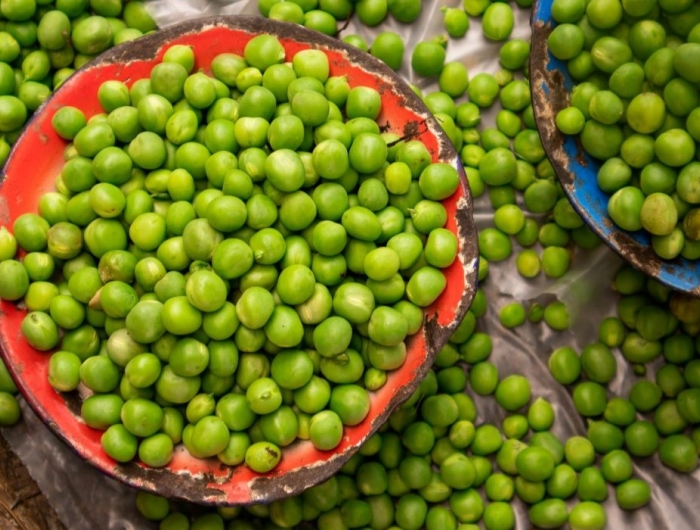
Giovanna Gomes - unsplash.com
As each new month arrives, it’s fun (and healthy!) to consider creative ways to incorporate seasonal produce into your routine. These peak-ripeness fruits and veggies are often grown closer to where you’re buying them, and for a variety of reasons, in-season produce can be more affordable than its hot-house or imported counterparts. Knowing what's in season is not only a great way to enjoy produce when it’s at its most delicious, but also a simple way to make produce the star of your grocery budget. Let’s see what’s in store this month.
April's best produce: Vegetables
Asparagus
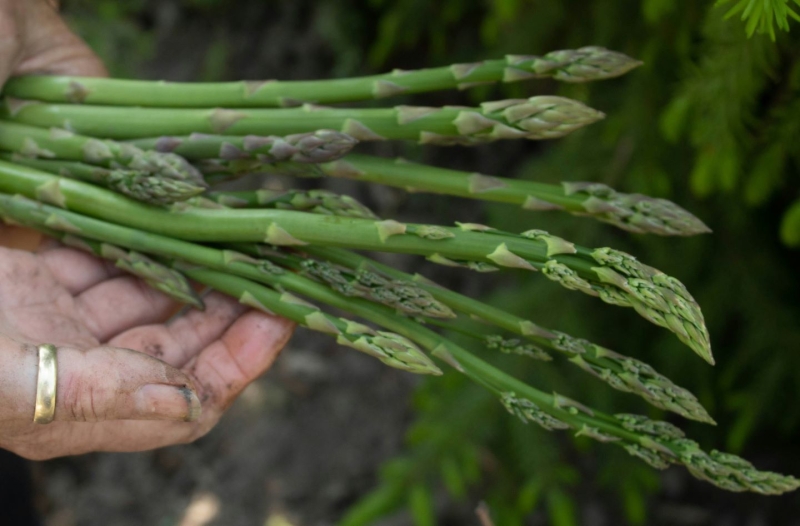
April is peak asparagus season! If you’ve ever seen white asparagus, you may have wondered whether it comes from the same plant as the more readily available green asparagus you often find in the produce section. They’re identical! The only difference is sun exposure; as the plant grows and emerges from the soil, the exposure to sunlight turns the spears green. To avoid sun exposure, white asparagus is usually grown underground.
Asparagus is versatile, delicious, easy to prepare, and, most importantly, nutritious. Though asparagus is low in calories, it’s dense in nutrients. Asparagus is an excellent source of Vitamin K, and also contains a bit of Vitamins C, A, and E, folate, potassium, phosphorus, iron, zinc, and riboflavin. Pretty impressive little spears!
How to choose and store asparagus
To choose the best asparagus, look for bunches with firm stems, bright green and purple-tinged spears, and tight tips. Avoid tips that have started to flower or open, and avoid stalks that are limp, wilted, or brownish in color. If you’re hoping for tender and sweeter flavors, choose bunches with thinner stems. And since these mighty spears spoil quickly, be sure to store them in the refrigerator; some suggest wrapping the bottom ends of the stalks in a wet paper towel to extend shelf life. Be sure to use asparagus within three to five days.
How to prepare asparagus
The versatility of asparagus is incredible: You can eat it raw on its own or in salads, and you can roast, grill, steam, boil, or sauté this vegetable to enjoy it as a side dish. You can also use asparagus in casseroles, soups, pasta dishes, frittatas, dips, stir-fry, and even as a pizza topping! The possibilities seem endless, but the simplest way to prepare this tasty veggie is to steam or roast it on its own. To steam, remove the woody ends or use a vegetable peeler to pare away the fibrous bits at the root end; you can save these to make stock! Wash well, place in a pan with about an inch of water, and cook with the lid on for 4 to 7 minutes. To roast, cut, wash, dry (important when roasting), place on a baking pan, toss with a bit of olive or canola oil and your favorite herbs, and bake at 425°F for 6 to 8 minutes. Squeeze some lemon over the spears, toss, and enjoy!
Looking for a few tasty recipes? Try these from The Healthy Cook Kate Sherwood:
Want even more options? Try these recipes from the USDA and Oregon State University:
Peas
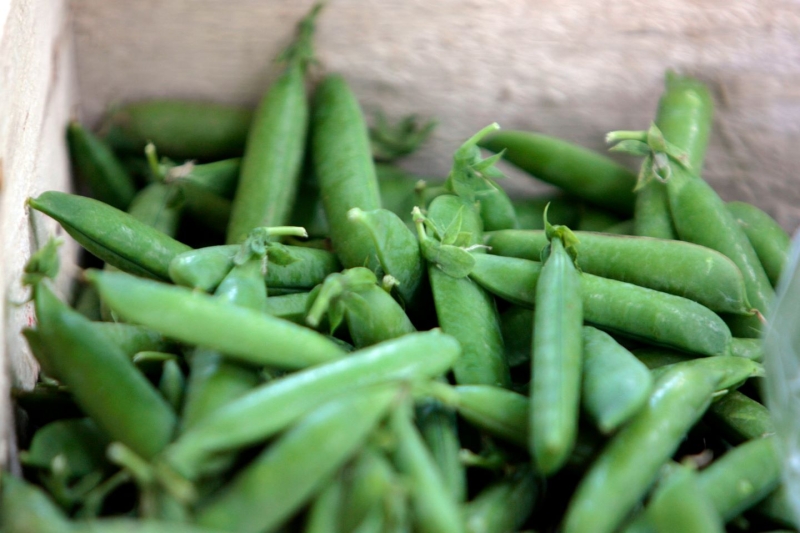
Humans have a very long history with peas. Researchers believe humans have been eating peas for about 9,500 years and cultivating them for 8,500 years. Ancient Greek and Roman writers even wrote about peas in some of their work! And that’s not the only fascinating thing about these pulses that act as vegetables. Since they remove nitrogen from the air and force it back into the soil, peas and other legumes help future plants grow. It’s an impressive symbiotic relationship!
There are three kinds of peas, and they’re all good for you. Sugar snap peas tend to emerge earlier in the spring and have a plump edible pod with peas inside; think of these as green beans’ curvier and sweeter cousins. Snow peas, conversely, have much flatter edible pods with tiny peas inside and are often used in stir-fries. And finally, there are shelling peas; inside a shelling pea’s fibrous and inedible pod live the green peas you’re probably most familiar with, also called garden or English peas. No matter which peas you choose, you’ll get a bit of protein, fiber, potassium, phosphorus, iron, zinc, copper, magnesium, and Vitamins C and K.
How to choose and store peas
To choose the most delicious fresh peas, choose more petite peas (large peas can be old and fibrous) with bright green pods and tendrils that aren't wilted or yellowing. Shelling peas should have plump pods; sugar snap peas and snow peas should have crisp pods with only a few small scars. And since fresh peas spoil within a few days, be sure to store them in the coldest part of your refrigerator in an open bag or perforated container (we want some air to get in) and enjoy within 3-5 days. When removing shelling peas from their pods, note that one pound of unshelled pea pods will yield about 1 cup of peas, and be sure to shell them right before cooking. Also, remember that only shelling peas have inedible pods; sugar snap and snow peas should be eaten whole. H4 How to prepare peas Peas can be enjoyed raw, steamed, blanched, boiled, or simply stirred into a very hot dish (which will cook the delicate peas). Raw sugar snap peas are a great snack on their own and can also substitute for chips when eating dips. Fresh peas are also great additions to salads, pasta dishes, rice dishes, casseroles, soups, stews, and stir-fries. For a simple side dish, steam fresh peas for 5 minutes or until bright green and fork tender. Add fresh herbs such as parsley, dill, or mint, and enjoy!
Looking for a few tasty recipes? Try these pea-forward dishes from The Healthy Cook Kate Sherwood:
Radishes
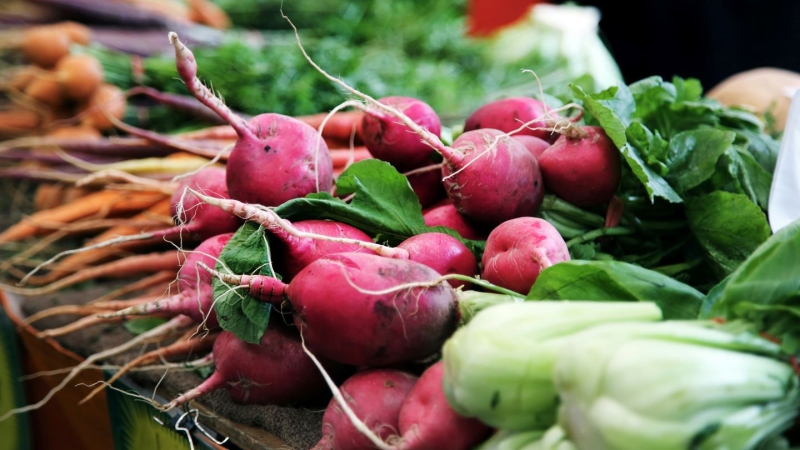
If you’re not yet a radish person, maybe it’s time to give these nutritious root vegetables a second chance. After all, radishes have been beloved by humans for centuries. Cultivated in Egypt around 2700 BCE, domesticated in China around 500 BCE, and replicated in gold as an offering to the Greek god Apollo, radishes have quite an interesting history.
But more importantly, these veggies are low in calories but high in nutrients. In fact, half a cup contains 10 percent of your recommended daily value of Vitamin C and a little fiber (about 2 grams per cup)—both great reasons to give radishes a chance.
How to choose and store radishes
To choose the freshest radishes, choose firm, smooth, brightly colored radishes with few blemishes. Avoid radishes that seem hollow when lightly squeezed. If their leafy tops are still attached, the greens should be dark green, vibrant, and without yellow patches. When refrigerated in a perforated plastic bag, fresh radishes should last up to one week.
How to prepare radishes
Fresh radishes can be eaten raw, thinly sliced on tacos, or added to slaws and salads. They can also be pickled to extend shelf life or added to stews, pot roasts, stir-fries, and a pan of roasted vegetables. In fact, roasting radishes is simple and brings out a bit of their sweetness. Simply toss with a little olive oil and your choice of spices and herbs, then arrange on a baking sheet in a single layer and roast for 30 to 35 minutes at 400°F. And if they’re still too bitter or peppery for you, consider peeling them; most of that peppery flavor lives in their bright skin.
Bonus tip: Don’t throw away those leafy radish tops! Radish greens are an entirely edible, woefully underappreciated produce that can be used in mixed greens salads and in cooking, just like other leafy greens such as spinach or kale. They have a slightly peppery flavor and can add a kick to your dish.
Looking for a few tasty recipes? Try these from The Healthy Cook Kate Sherwood:
April's best produce: Fruit to look for this month
As yummy as April’s vegetables are, the fruit of April is also cause for celebration: Strawberries start to emerge in April, and though we'll see less of some of our favorite citrus fruits this month (like mandarins), blood oranges are still in season. Perhaps the most exciting "fruit" to begin emerging this month is a vegetable that acts as a fruit: rhubarb!
Blood oranges
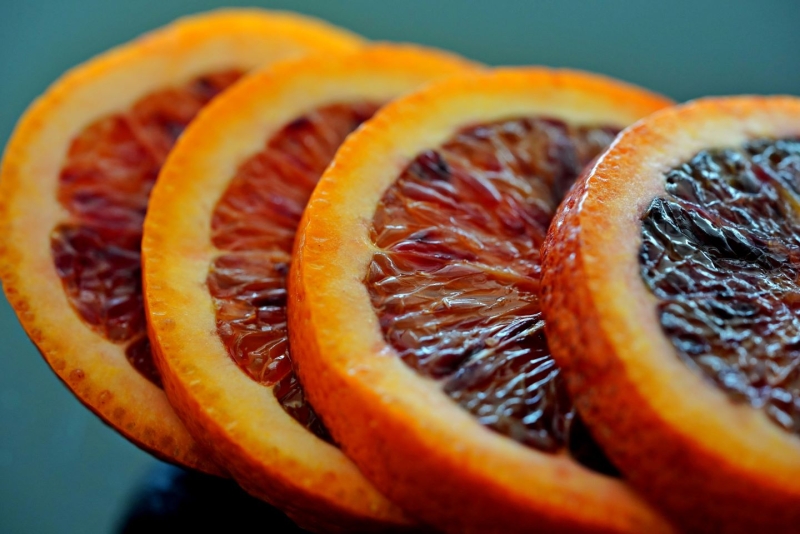
Many of us already know that oranges are a great source of Vitamin C—providing as much as 90 percent of the recommended Daily Value in a single medium-sized fruit—you might be surprised to know they even contain a bit of fiber, calcium, and folate, as well. All this, and they’re delicious too!
How to choose and store blood oranges
As with any produce, there's a trick to picking the best citrus. The best blood oranges are those that seem heavy for their size. That’s a good sign that they have a higher water content; that means they’ll be nice and juicy! And since their thick peels protect these fruits from going bad quickly, you can store whole blood oranges on the counter for a few days (more than two days is probably pushing it) or in the refrigerator for up to two weeks.
How to prepare blood oranges
Blood oranges are beautiful just as they are, so we highly recommend having one straight from the peel. But they’re great for adding a punch to salads, salsas, and marinades. Top baked white fish with a blood orange salsa, and add blood oranges to an arugula salad (the bitter greens pair nicely with the sweetness of the orange).
Looking for a tasty recipe? Try these citrusy options from The Healthy Cook:
Rhubarb
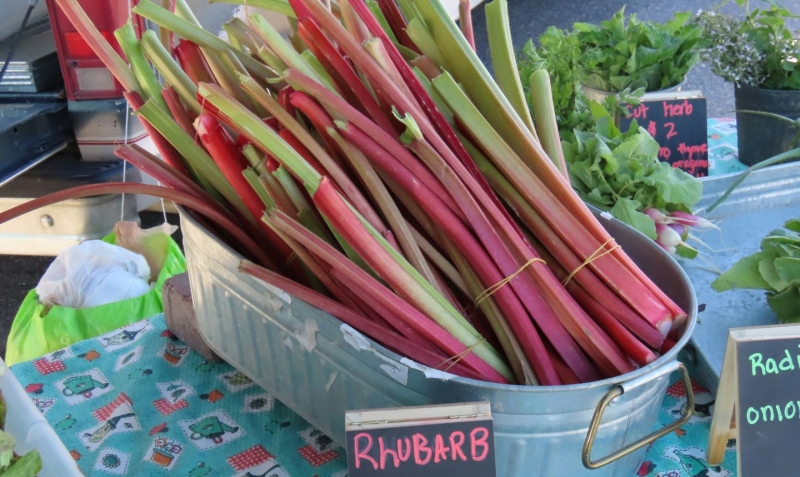
One important thing to know about rhubarb from the start? Only eat the stalks! The leaves contain a toxic substance that makes them poisonous to humans and animals when ingested. So, if you purchase rhubarb with its leaves, remove and dispose of those leaves as soon as you get home.
You might think that rhubarb requires a lot of added sugar to be tasty. And sure, the stalks can be pretty tart, but the trick is to combine rhubarb with other fruits like strawberries (also emerging in April!) to decrease the amount of added sugar needed. Rhubarb stands out as an excellent source of Vitamin K, with one cup offering roughly 20 percent of what adults need in a day, as well as small amounts of magnesium, folate, and potassium. So, if you’ve been on the fence, it might be time to give rhubarb another chance!
How to choose and store rhubarb
To choose the tastiest rhubarb, buy stalks that are straight, firm, and bright pink or red (the brighter and darker, the sweeter and less tart they’ll be). Avoid stalks that are wilted or flabby. You can store them in a plastic bag in the produce drawer (it’s the coldest drawer!) of your refrigerator for up to seven days. H4 How to prepare rhubarb Once you dispose of the leaves (very important—they’re poisonous!), you can use rhubarb in pies, cobblers, soups, and even smoothies.
Looking for a few tasty recipes? Check out these fun, low- or no-added-sugar ideas:
Strawberries
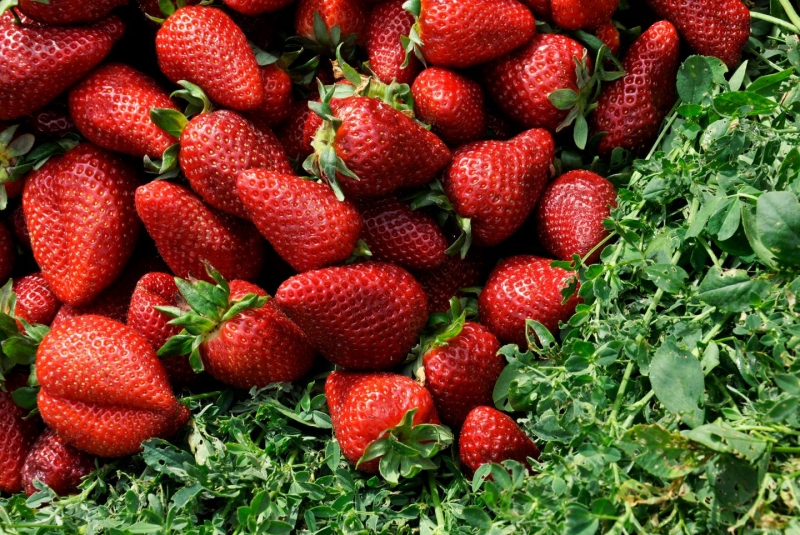
Does it surprise you to learn that strawberries aren’t actually berries? It’s true! Botanists (plant scientists!) define strawberries as a “pseudocarp,” or false fruit, made up of many tiny fruits. What we call a strawberry is actually an “accessory fruit” and is thus not a true berry. Kind of neat, right?
Berry or not, strawberries are an irresistibly sweet treat. And each cup is a good source of fiber and packs in nearly a full day’s Vitamin C. Strawberries are also 90 percent water, so their calorie density is low, even compared to most other fruits. That explains why a pound of them delivers just 150 calories. That works out to about 50 calories per cup. There’s no better way to bulk up yogurt, cereal, or even ice cream.
How to choose and store strawberries
Strawberries don’t continue to ripen once picked, so a darker berry means it was picked at its most ripe. To pick the tastiest strawberries, choose medium-sized berries with no white tips or green spots. Make sure they’re firm, plump, and uniformly deep red. And since these fragile fruits tend to spoil quickly, be sure to keep them refrigerated (preferably in the crisper drawer) in a closed clamshell container or porous plastic bag (they like humidity!) and enjoy them within 7 days.
How to prepare strawberries
In addition to slicing and eating plain, you can enjoy strawberries in salads, smoothies, and yogurt parfaits and add them to oatmeal or cold cereal. As a treat, top with a dollop of whipped cream and you have a satisfying yet simple dessert.
Looking for a quick strawberry recipe? Try these winning recipes from Kate Sherwood, The Healthy Cook:
Want even more strawberry goodness? The USDA’s MyPlate database has you covered.
M.M. Bailey (she/her) is a writer who lives in the DC metro area. Her writing has been featured in Fall for the Book’s October 2021 podcast series and can be found in Fractured Lit, This is What America Looks Like, Furious Gravity, and Grace In Love, among others. Her special interests have focused on cultural representations of gender and race, as well as the role of visual narratives in social justice and reform.
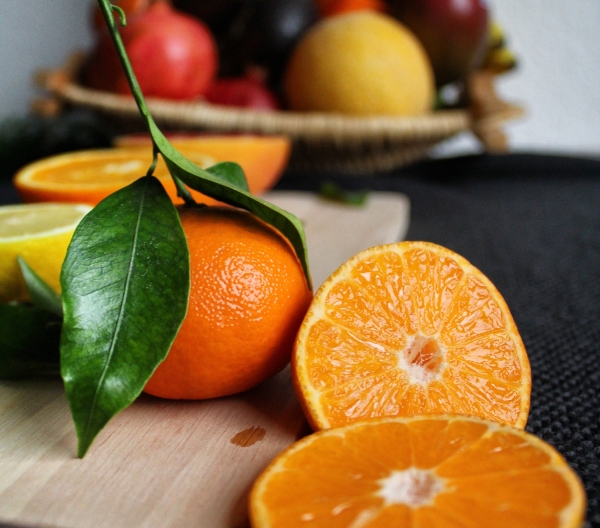
Subscribe to Nutrition Action
We name names, remain strictly objective, and deliver scrupulously researched advice about food of all kinds, staying healthy with diet and exercise, and more.


